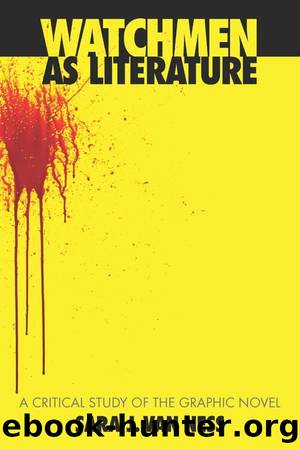Watchmen as Literature by Sara J. Van Ness

Author:Sara J. Van Ness [Ness, Sara J. Van]
Language: eng
Format: epub
Publisher: McFarland & Company, Inc., Publishers
Published: 2014-11-29T00:00:00+00:00
Fig. 6.4. Rorschachâs visit brings back Dreibergâs memories of the past (Moore and Gibbons 1.13).
With the imposition of the Keene Act, Dreiberg voluntarily complied with the governmentâs mandatory retirement. He placed his costume, gadgets, and other inventions in an underground lair, beneath his New York City apartment, and did not use them for years (4.23). He is apparently unhappy with his present life at the beginning of the novel, especially when Rorschach pays him a visit, which conjures old memories of his past life as a masked adventurer (1.13). When Rorschach leaves, Dreiberg is pictured with the late Comedianâs button in hand, a reminder of his past crime-fighting days (see figure 6.4). Next to him hangs his unused costume, which appears to be in immaculate condition. His body, slumped over and shadowed, is directly contrasted to the hollow costume, which ironically stands prominently, illuminated from the front and casting a shadow behind it. The wall behind Dreiberg is stained and damaged, while the locker that holds his costume is pristine. The railing to Dreibergâs left casts a shadow that descends diagonally away from his body, but the railings in front of the costume ascend with strong vertical lines. Even the costumeâs belt, which would normally be worn horizontally, instead accentuates the vertical lines of the alcove and locker. In one hand he holds his glasses loosely, and they dangle lifelessly from his fingertips. The goggles around the neck of his costume are horizontal and stable. The image suggests that the empty garments hold more authority than the man who once wore them. Who is really living in the âshadowsââDreiberg the civilian or the former Nite Owl?
Dreiberg is visibly distraught by the loss of his heroic identity as the Nite Owl, but he continues to deny its effect on his life. He thinks that he âeventually [...] realized the Comedian was rightâitâs all crap dressed up with a lot of flash and thunderâ (7.8). However, his words do not match his obvious demeanor in the previously discussed panel. It is as though he wants to convey that he no longer desires to be a masked adventurer to Laurie Juspeczyk, the former Silk Spectre II, who believes her time as a masked adventurer âwas nothing more than ten years running round in a stupid costume because [her] stupid mother wanted [her] to!â (1.25). Dreibergâs weekly visits to see Hollis Mason, the first Nite Owl, as well as his visually evident distress, strongly suggest otherwise. He is denying his natural heroism, constricting himself to following the conventional laws.
Dreiberg continues to downplay the importance of his past as Nite Owl as he and Juspeczyk examine the damage to his Owl Ship: âbeing a crimefighter and everything. It was just this adolescent, romantic thingâ (7.7). He conveys that âadventuringâ was merely playing out a childhood dream. Becoming a masked adventurer was not only âromanticized,â but also âadolescent.â This suggests that he feels that his past life as the Nite Owl was childish, and the mask, costume, and gadgets merely offered some type of fantasy fulfillment.
Download
This site does not store any files on its server. We only index and link to content provided by other sites. Please contact the content providers to delete copyright contents if any and email us, we'll remove relevant links or contents immediately.
4 3 2 1: A Novel by Paul Auster(11087)
The handmaid's tale by Margaret Atwood(6886)
Giovanni's Room by James Baldwin(5910)
Big Magic: Creative Living Beyond Fear by Elizabeth Gilbert(4743)
Asking the Right Questions: A Guide to Critical Thinking by M. Neil Browne & Stuart M. Keeley(4612)
On Writing A Memoir of the Craft by Stephen King(4233)
Ego Is the Enemy by Ryan Holiday(4013)
Ken Follett - World without end by Ken Follett(3985)
The Body: A Guide for Occupants by Bill Bryson(3841)
Bluets by Maggie Nelson(3736)
Adulting by Kelly Williams Brown(3690)
Guilty Pleasures by Laurell K Hamilton(3607)
Eat That Frog! by Brian Tracy(3536)
White Noise - A Novel by Don DeLillo(3447)
The Poetry of Pablo Neruda by Pablo Neruda(3380)
Alive: The Story of the Andes Survivors by Piers Paul Read(3327)
The Book of Joy by Dalai Lama(3245)
The Bookshop by Penelope Fitzgerald(3242)
Fingerprints of the Gods by Graham Hancock(3233)
